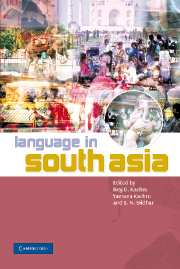Book contents
- Frontmatter
- Contents
- List of Figures
- List of Maps
- List of Tables
- Preface
- Acknowledgments
- List of Abbreviations
- Note on Transcription
- Introduction: languages, contexts, and constructs
- Part 1 Language history, families, and typology
- Part 2 Languages and their functions
- 3 Hindi–Urdu–Hindustani
- 4 Persian in South Asia
- 5 Major regional languages
- 6 Minority languages and their status
- 7 Tribal languages
- Part 3 Sanskrit and traditions of language study
- Part 4 Multilingualism, contact, and convergence
- Part 5 Orality, literacy, and writing systems
- Part 6 Language conflicts
- Part 7 Language and modernization
- Part 8 Language and discourse
- Part 9 Language and identity
- Part 10 Languages in diaspora
- References
- Subject Index
- Language Index
- Author Index
3 - Hindi–Urdu–Hindustani
Published online by Cambridge University Press: 04 May 2010
- Frontmatter
- Contents
- List of Figures
- List of Maps
- List of Tables
- Preface
- Acknowledgments
- List of Abbreviations
- Note on Transcription
- Introduction: languages, contexts, and constructs
- Part 1 Language history, families, and typology
- Part 2 Languages and their functions
- 3 Hindi–Urdu–Hindustani
- 4 Persian in South Asia
- 5 Major regional languages
- 6 Minority languages and their status
- 7 Tribal languages
- Part 3 Sanskrit and traditions of language study
- Part 4 Multilingualism, contact, and convergence
- Part 5 Orality, literacy, and writing systems
- Part 6 Language conflicts
- Part 7 Language and modernization
- Part 8 Language and discourse
- Part 9 Language and identity
- Part 10 Languages in diaspora
- References
- Subject Index
- Language Index
- Author Index
Summary
Introduction
Hindi is a New Indo-Aryan language spoken in the north of India. It belongs to the Indo-Iranian branch of the Indo-European family of languages. It is spoken by more than two hundred million people either as a first or second language in India, and by peoples of Indian origin in Trinidad, Guyana, Fiji, Mauritius, South Africa, and many other countries. It is the official language of India, and English is the associate official language. In addition, Hindi is the state language of Bihar, Chattisgarh, Jharkhand, Haryana, Himachal Pradesh, Madhya Pradesh, Rajasthan, Uttarakhand, and Uttar Pradesh.
Urdu, a language closely related to Hindi, is spoken by twenty-three million people in India and approximately eight million people in Pakistan as a mother tongue. It is the official language of Pakistan, the state language of Jammu and Kashmir, and additional state language of Bihar and Uttar Pradesh in India.
Hindi and Urdu have a common form known as Hindustani which is essentially a colloquial language (Verma 1933). This was the variety that was adopted by Mahatma Gandhi and the Indian National Congress as a symbol of national identity during the struggle for freedom. It, however, never became a language of literature and high culture (see Bhatia 1987 and Rai 1984 for an account of the Hindi–Urdu–Hindustani controversy in the late nineteenth and early twentieth centuries).
Background
It is difficult to date the beginnings of the New Indo-Aryan languages of India.
- Type
- Chapter
- Information
- Language in South Asia , pp. 81 - 102Publisher: Cambridge University PressPrint publication year: 2008
- 11
- Cited by

